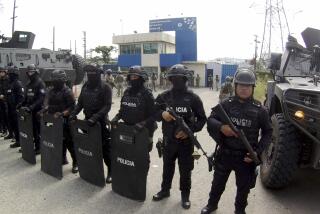Panama: The Road to Recovery : Thousands Have Sought Refuge in Embassies
- Share via
WASHINGTON — In taking refuge in the offices of the papal nuncio in Panama City, Gen. Manuel A. Noriega has borrowed a popular technique from the dissidents of the world, thousands of whom have sought protection and escape through foreign embassies throughout the 20th Century.
Under international law, foreign embassies and the ground on which they sit are considered the territory of the country to which they belong. Forces from outside countries cannot legally enter embassies to retrieve people who have been provided safe haven. The papal nuncio, as the Vatican’s diplomatic representative, enjoys such status.
The vast majority of cases in which individuals have sought refuge inside foreign embassies are quite different from Noriega’s, however, at least as the United States views the deposed Panamanian dictator.
Most of those seeking diplomatic asylum in recent years have been dissidents and others fleeing from brutal regimes or hard-line Communist countries.
Last June, Chinese dissident Fang Lizhi fled to the U.S. Embassy in Beijing after the massacre of hundreds of protesters demanding democratic reforms. Lizhi remains inside the embassy, under threat of arrest by Chinese authorities if he leaves.
Hungarian Cardinal Josef Mindszenty lived for 15 years at the U.S. Embassy in Budapest, until the mid-1960s. Hungarian authorities had arrested him and sentenced him to life in prison for being an enemy of communism in 1948.
In a harrowing escape from Iran in 1979, a handful of Americans got away by hiding at the Canadian Embassy in Iran. They were quickly smuggled from the country by Canadian diplomats. Fifty-two who were less fortunate spent 444 days as hostages and gained worldwide attention.
From 1978 to 1983, seven Pentecostalists lived for five years in a single room at the U.S. Embassy in Moscow after fleeing from Soviet religious persecution.
Aside from these small groups and individuals, huge numbers of people have at times sought refuge by crowding the grounds of foreign embassies in their homelands.
In 1980, 10,000 Cubans descended upon the Peruvian Embassy seeking to emigrate. Most eventually received exit visas and arrived in the United States in what became known as the Mariel boatlift.
More to Read
Sign up for Essential California
The most important California stories and recommendations in your inbox every morning.
You may occasionally receive promotional content from the Los Angeles Times.










